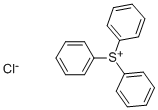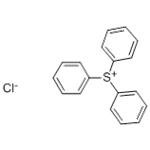Triphenylsulfonium chloride is used as a key intermediate that is widely used in the new electronic chemicals such as semiconductor, LCD and TFT. It is also used as a photoacid generator (PAG) in Catalyst activation through in situ photogeneration of ligands.
Triphenylsulfonium Chloride Synthesis: Diphenyl sulfoxide, 40 g (0.2 mole), was dissolved in 400 g of dichloroethane, which was stirred under ice cooling. At a temperature below 20° C., 65 g (0.6 mole) of trimethylsilyl chloride was added dropwise to the solution, which was aged for 30 minutes at the temperature. Then, a Grignard reagent which had been prepared from 14.6 g (0.6 mole) of metallic magnesium, 67.5 g (0.6 mole) of chlorobenzene and 168 g of tetrahydrofuran (THF) was added dropwise at a temperature below 20° C. The reaction solution was aged for one hour, after which 50 g of water at a temperature below 20° C. was added to quench the reaction. To this solution, 150 g of water, 10 g of 12N hydrochloric acid, and 200 g of diethyl ether were further added.
The water layer was separated and washed with 100 g of diethyl ether, yielding an aqueous solution of triphenylsulfonium chloride. The compound in aqueous solution form was used in the subsequent reaction without further isolation.



